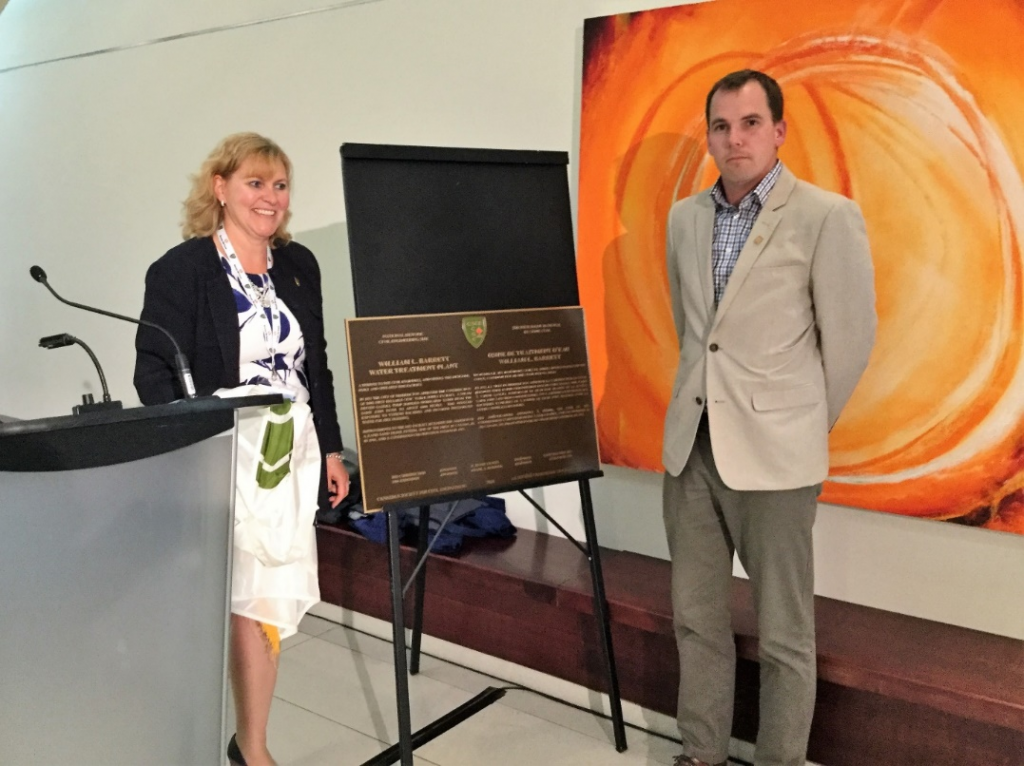

Site Location: Lat.: 45° – 57’ – 04” N.; Long.: 66° – 39’ – 55” W. (GPS: 45.9649529, -66.6533834). 101 Smythe St. Fredericton, NB. From Trans-Canada Highway 2, take Exit 285 and follow NB Highway 101 (Regent Street) north towards downtown Fredericton. Drive 6.1 km on Highway 101 (Regent Street) with no turns until it reaches the Saint John River and then turn left along the river. Drive past Westmorland Street after which it again turns left to become Smythe Street. The William L. Barrett Water Treatment Plant is on the right. Parking is available on local side streets.
Plaque Location: The plaque is installed on an exterior wall beside the main entrance to the Water Treatment Plant on the north face of the building (i.e, the side facing the river).

Description: The William L. Barrett Water Treatment Plant has been a mainstay of the Fredericton water supply system since the 1880s. In 1883, a water pumping station was constructed under the direction of N. Henry Crafts, an engineer from Boston, to supply 1.8 million litres per day to the 6,000 citizens of Fredericton. The station pumped untreated water from the Saint John River through 14 km of pipes and to 80 fire hydrants. In 1906, Mooney & Sons of Saint John constructed a rapid sand filter system designed by Frank A. Barbour, an engineer from Boston. In 1912, John Feeney, a 1910 graduate of the University of New Brunswick, designed and implemented a continuous chlorination system. It remained in operation until 1950 when a new bell-jar gas chlorinating system was installed. From 1955 to 1959 the City supply transitioned from river water to groundwater. In 1984, installation of a pressurized filtration system facilitated removal of increasing concentrations of manganese from the groundwater while supplying 15 million litres per day.

Historic Significance: Although the facility has benefitted from technological innovations over the years, the initial 1883 building is still a part of one of the current water treatment plants. At the turn of the last century, it was one of the most complete filtration plants for municipal water supply in Canada. Feeny’s continuous chlorination system was implemented only four years after the first municipal continuous chlorination system became operational in the United States. The manganese removal system was, at the time, the largest of its kind in North America.
In June 2007, the name of the facility was changed to the William L. Barrett Water Treatment Plant to honour Mr. Barrett, who served as City Engineer for the City of Fredericton from 1953 to 1979.

Plaque Unveiling Ceremony: The plaque was unveiled at the Fredericton Convention Centre on the afternoon of Thursday June 14, 2016. The Master of Ceremonies was John Bliss, Honorary Chair of the 2018 CSCE National Conference Local Organizing Committee. Susan Tighe, CSCE President, and Hon. Lisa Harris, Minister, Government of New Brunswick, made brief remarks. Laurie Corbett, formerly with Fredericton’s Water and Sewer Division, gave a short description of the history and significance of the facility and introduced Mr. William L. Barrett, who spoke briefly. The plaque was officially received by Fredericton Mayor Mike O’Brien.



Plaque Text: National Historic Civil Engineering Site. BARRETT WATER TREATMENT PLANT. A tribute to the Civil Engineers, and others who designed, built and operated this facility. In 1883 the City of Fredericton approved construction of this first reliable civic water supply facility. A steam driven Gaskill pump supplied untreated water from the Saint John River to about 6000 people. This reduced exposure to typhoid bacteria and provided pressurized water for fire fighting. Improvements to the 1883 facility included the addition of a rapid sand filter system, one of the first in Canada, in 1906, and a continuous chlorination system in 1912. Canadian Society for Civil Engineering. 2018.
Site historique national de génie civil. USINE DE TRAITEMENT D’EAU WILLIAM L. BARRETT. Un hommage aux ingénieurs civils et autres intervenants qui ont conçu, construit et exploité cette installation. En 1883, la ville de Fredericton approuve la construction de cette première usine d’approvisionnement en eau civile fiable. Un pompe à vapeur Gaskill fournissait de l’eau non traitée de la rivière Saint John à environ 6 000 personnes. Cela a réduit l’exposition aux bactéries typhoïdes et a fourni de l’eau sous pression pour la lutte contre les incendies. Des améliorations apportées à l’usine, qui date de 1883, comprennent l’ajout d’un filtre à sable rapide, l’un des premiers au Canada, en 1906, et d’un poste de chloration continue en 1912. 2018. La société canadienne de génie civil.
Link to Further Documentation:
Dale I. Bray, “William L. Barrett Water Treatment Plant”, Canadian Civil Engineer, 2018. (See page 10).